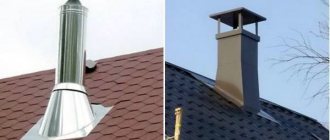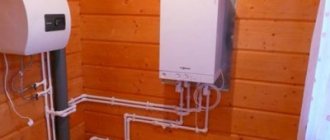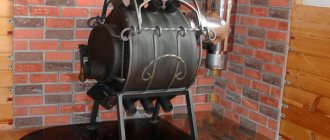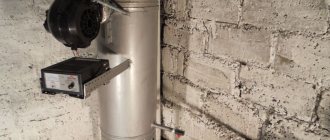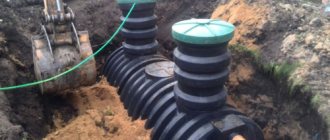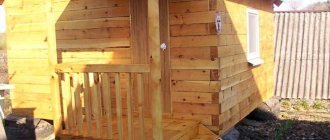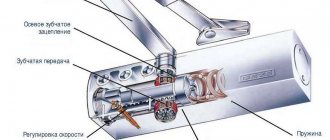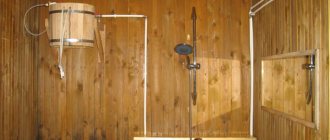How to make a sewer in a bathhouse
How to make a sewer in a bathhouse
In simple village baths, they did not think much about sewerage. Wastewater simply went into the ground through the slatted floor. In modern private estates this has long been abandoned. Now, when building a bathhouse, the disposal of wastewater is carefully considered, observing all the rules in order to protect both the building and the site from the effects of wastewater.
What to consider?
In order for the liquid removal system from the bath to work effectively and for a long time, several rules must be followed.
- It is necessary to plan and install the sewer system at the stage of laying the foundation and arranging the floor. It is important to leave a hole in the base of the building for the outlet pipe, and before pouring the screed, dig trenches and lay the pipes.
Planning the sewer system should be done long before the construction of the bathhouse
- Even if you plan to steam and wash in different rooms, you still need to install a drain in the steam room. After all, after each bath procedure, this compartment must be thoroughly rinsed from a hygienic point of view.
Drain hole with grate
- Since I most often use gravity-type sewerage in the bathhouse, when laying pipes it is necessary to maintain a slope of 2-3 cm per linear meter. Floors should also be made with a slope towards the drain hole.
- If a gravity sewer will drain wastewater from different rooms, then it is necessary to install a riser for ventilation.
- Where water enters the drain hole and enters the sewer pipe, there must be a water seal that prevents unpleasant odors from penetrating into the bathhouse premises.
SEWER. EXTERNAL NETWORKS AND STRUCTURES SNiP 2.04.03-85
SNiP 2.04.03-85
In addition, when designing external sewerage, it is necessary to take into account 2 natural parameters:
- type of soil;
- depth of soil freezing.
The last factor is important to know when laying internal drainage pipes. This point for some regions of Russia is indicated in the table.
| Regions | Maximum depth of zero soil temperatures, m |
| Moscow region | 1,2–1,32 |
| Leningrad region | 1,2–1,32 |
| Nizhny Novgorod Region | 1,4-1,54 |
| Oryol Region | 1,0-1,1 |
| Novosibirsk region | 2,2-2,42 |
| Astrakhan region | 0,8-0,88 |
| Arhangelsk region | 1,6-1,76 |
| Khanty-Mansi Autonomous Okrug | 2,4-2,64 |
| Sverdlovsk region | 1,8-1,98 |
| Chelyabinsk region | 1,8-1,98 |
| Saratov region | 1,4-1,54 |
| Samara Region | 1,6-1,76 |
| Omsk region | 2,0-2,2 |
| Orenburg region | 1,6-1,76 |
| Rostov region | 0,8-0,88 |
| Smolensk region | 1,0-1,1 |
| Tomsk region | 2,0-2,2 |
| Tyumen region | 1,8-1,98 |
| Republic of Bashkortostan | 1,8-1,98 |
| Stavropol region | 0,6 – 0,66 |
More detailed information taking into account the type of soil, as well as calculations, are given in SNiP 2.02.01-83 and SNiP 23-01-99. If it is not possible to lay communications deeper than this mark, then the pipes must be insulated.
SNiP 2.02.01-83. Foundations of buildings and structures
SNiP 2.02.01-83 Foundations of buildings and structures
Construction climatology. SNiP 01/23/99
SNiP 01/23/99
Let's take a closer look at the process of installing a system for removing and recycling wastewater from a bathhouse.
Mobile dry toilets
A more fashionable name is powder-closet (dry toilet). Does not require any construction work, no water supply or cesspool required. The body's waste products are collected in sealed containers with peat, and the contents are removed as they are filled. Where? Question. You can’t throw it into a flowerbed, as the manufacturers advertise; you’ll have to dig a separate hole each time or build a large storage tank. And if it’s winter, how to dig holes on the site?
Peat dry toilets
But this is not all the problems that arise when using dry closets. Can you imagine a relaxation room in a bathhouse or dressing room, in the corner of which there is a dry closet? No? And we can't. In this regard, we strongly do not recommend purchasing such devices and do not believe the manufacturers’ advertising brochures. You can take these toilets with you when you go on a picnic. And then only if you are a very well-mannered person, you don’t throw anything away in the forest and you bring all the waste to your dacha and bury it in the garden bed.
Peat dry toilet
Disposal of peat from a dry closet
Prices for peat dry toilets
peat dry closet
Internal network and its installation
Concrete screed and drain
The type of sewage system running inside the bathhouse depends on the type of floor. Today, concrete screed is most often made. Tiles can be laid on it or a slotted wooden floor can be installed on the joists. The gap between the floorboards in the latter case will be about 5 mm.
The photo shows leaking floors
Note! For safety reasons, when choosing tiles, it is better to opt for a product with a rough surface that will not slip.
But, as mentioned above, before the floors are laid out and at the stage of laying out the foundation, it is necessary to begin the arrangement of the sewerage system.
Note! The sewage outlet from the bathhouse is made where the washing room will be located. It is in this section of the base of the bathhouse that a hole is left for the outlet sewer pipe.
All this must be taken into account in the design of the bathhouse and the drainage system from it, in accordance with which the entire sewage system is installed in stages. But first you need to prepare all the materials and tools.
Leak-proof bath floor
Which pipes to choose
In fact, the choice of sewer pipes is not so large.
| Type of pipes | Description |
Cast iron pipes for sewerage | It is irrational to use cast iron in our time: they are expensive, heavy and inconvenient to install. Ceramic ones are ideal in any respect, but also have a high cost. |
Asbestos cement pipes | Asbestos-cement ones are the cheapest of all possible, but they often disappoint with their defects. In addition, when installing a non-pressure sewer system, products with smooth and even walls are required. And asbestos-cement ones have a rough inner surface, often riddled with depressions. |
Plastic pipes | The optimal choice is plastic pipes that are resistant to all types of destructive influences. These products are excellent for installing internal and external sewage systems, are flexible in processing, and are available with or without a socket. The warranty period for plastic pipes is 50 years. For long products, shaped elements (fittings) are offered, with the help of which the sewer system is installed. |
The category of plastic pipes includes:
- PVC (polyvinyl chloride);
- PVC (chlorinated polyvinyl chloride);
- PP (polypropylene);
- HDPE (low density polyethylene);
- polyethylene corrugated.
Any of these products can be safely used in a sewer system. The diameter of the main line is selected based on the expected intensity of operation of the building and the number of drain points. For an average bathhouse with a steam room, washing area and toilet, when installing a gravity drainage system, pipes with a cross-section of 100-110 mm are required. If a toilet is not provided, a diameter of 50 mm is sufficient. Plumbing equipment is connected to the main line with pipes with a cross-section of 50 mm.
Prices for plastic pipes for sewerage
plastic pipe for sewer system
Laying the internal sewage system of a bathhouse
Step 1. Inside the bathhouse, trenches are prepared in the ground at least half a meter deep from the soil surface. The width of the ditches should be slightly larger than the diameter of the internal drainage pipes.
Trench for sewer pipeline (external)
Note! When digging trenches, it is recommended to take into account the places where the sockets will pass in order to make small recesses for them.
Step 2. Create a slope in the ditch towards the point where the sewage system exits the room. Check the angle using a construction hydraulic level.
Step 3. Fill the bottom of the trenches with sand and compact it. The layer thickness is 10-15 cm. At this stage, you also need to maintain a slope.
Step 4. Lay all the pipes. The horizontal pipeline should run 30 cm above the point of greatest soil freezing. It is recommended to insulate the pipes.
Slope of sewer pipes
Note! The section of the pipeline running in the foundation is mounted using a metal sleeve.
Step 5. Vertical pipes are also installed, to which drains or a tee for the toilet will be connected in the future. To do this, sticks or metal pins are dug into the ground, to which the pipes are fixed. The length of vertical pipelines must be taken with a margin. The excess will be cut off when installing water intakes.
You may be interested in information - mole septic tank
Step 6. Install the ventilation riser. It is attached to the wall using clamps. The vertical pipe is brought above the roof or cut indoors and a check valve is installed at the top hole of the riser.
Ventilation riser diagram
Step 7. While pouring the floor, drains are installed. If you plan to also lay tiles on the screed, this must be taken into account when installing water inlets. The screed should have a slope towards the ladder. The tiled or wooden covering is laid after the concrete has dried.
Sewage drainage
Sewage and water supply systems
Sewer drain
Shower drain assembly diagram
Step 8. If necessary, connect the toilet, washbasin and other equipment.
Bathhouse, bathroom
The internal sewage system is ready, but it is unacceptable to use it without connecting to external elements.
Sewer system assembly procedure
Creating a system is not very difficult and is usually done on your own. The process consists of several stages. Step-by-step instruction:
- creating a project. It is necessary to draw up a sewerage diagram, create a site plan to scale indicating the location of the drainage well and the trench line;
- production of earthworks. A recess is dug for the tank, trenches and a pit (if needed);
- assembling the internal section and bringing the pipe out;
- assembly of the external part of the system;
- checking functionality, filling the sinuses.
The first point should not be neglected. When creating a sewer system in a bathhouse with your own hands, the diagram allows you to think through and resolve many issues before starting direct action.
About all the advantages of this method in the video below
Internal section
The internal part of the system is assembled before the floor is laid. First, determine the installation height of the ladder. This is the control point for raising the drain pipe. Marks are drawn along it corresponding to the minimum level of the flooring. If several drains are required, their installation points are immediately marked and connecting pipes are installed. They are combined into one common pipeline, which is led out through a hole in the foundation - into a trench or open drain tray. The floor is poured only after fixing the pipelines in a certain position.
Drainage with pit
The pit is a recess designed to accommodate outlet parts - the siphon of the ladder, pipelines and additional elements. It is usually used in prefabricated buildings where the floor height above the ground is too low. Sometimes an intermediate storage tank is placed in the pit. It serves as a good addition to a treatment system that is not capable of quickly releasing moisture into the soil. As the tank fills, water enters the common pipeline and is discharged into the drainage well. This reduces the load on drainage. The rate of water absorption into the soil is reduced, and primary wastewater treatment is performed.
Wastewater disposal options and their implementation
There are several ways to dispose of wastewater after a bath:
- central sewerage;
- septic tank;
- filtration well;
- cesspool.
Each of these options can be used under certain conditions and for different purposes.
Connection to central sewer networks
Connection to central sewer networks
This is the most convenient way to dispose of wastewater. To implement it, you must obtain permission from the service organization and enter into an agreement with it. An inspection well is installed at the connection point to the main line.
Since the services of contractors can be expensive, and during the registration process you will have to deal with the Russian bureaucratic system, to receive a small amount of wastewater, it is better to use other methods, for example, soil filtration.
Filtration well
Filtration well
This is one of the most popular options for draining wastewater from a bathhouse that does not have toilets. But it is feasible only in conditions of low groundwater level and permeable soil.
To implement this, you need to purchase a container without a bottom, for example, a plastic pipe. It can be replaced with concrete rings and even old tires that are mounted on top of each other.
Filtration well. Plan, section 1-1. M 1:25
The construction of the well is carried out according to a simple scheme.
Step 1. Dig a trench for the pipeline, maintaining a slope to the site where the future well will be installed.
Step 2. They dig a pit at a distance of about 3 m from the bathhouse, the minimum area of which is 1 m2, and the depth should be greater than the freezing level of the soil. This will be the site for soil filtration.
Pit
Step 3. A bottomless container is installed in the hole.
Step 4. The bottom of the trench for the supply pipeline is filled with sand and compacted, not forgetting to maintain the slope.
Step 5. Lay the pipeline and connect it to the well. If necessary, the pipe is additionally insulated, for example, sprinkled with expanded clay.
Step 6. Filter material, for example, crushed stone, is poured into the resulting well. The height of the backfill should be slightly higher than the zero temperature point of the soil.
The photo shows the connection of the pipeline and backfilling of crushed stone
Step 7. Install the ceiling or neck with a hatch.
Filtration well cover
Step 8. Backfill the well and pipes.
Periodically you need to check the condition of the filter media, and if necessary, change it or wash it.
Septic tank
Septic tank
If a lot of wastewater is generated, and besides, a toilet is installed in the bathhouse, then it is recommended to install a septic tank to dispose of bathwater. You can also connect to an existing local sewer system. Moreover, the second option is much more profitable, since it does not require additional investments. But bath drains (their quantity) must be taken into account when choosing the performance of a septic tank.
Septic tank installation process
cesspool
Since the bathhouse is not used every day, not too much wastewater is generated, one of the options for collecting wastewater is a simple cesspool, which will have to be emptied periodically by calling a sewer truck.
Brick cesspool
A sealed catchment container is installed in a convenient place, and a pipeline coming from the bathhouse is connected to it. This method can be used where soils are poorly permeable to water and fecal contamination is present in the drains.
Sewage for a bathhouse, although it requires taking into account several nuances, can be installed independently. The main thing is to choose the right method for waste disposal, observe the slope for the gravity system and take into account the natural features of the area.
Features of the arrangement
The toilet must be protected from the penetration of steam and moisture. Waterproofing a bathroom in a bathhouse is an important condition for its arrangement. During construction, the walls of this room must be covered with a layer of moisture-proof material, which, as a rule, is roofing felt or thick polyethylene film. In addition, it is necessary to provide a vapor barrier, for which a layer of polymer film with foil is laid. In attached toilets, there is also a need for thermal insulation. It is made of mineral wool, polystyrene foam and other materials. A corner bathhouse with a bathroom also requires increased attention, where the likelihood of exposure to moisture from the outside should also be taken into account.
The bath floor must be waterproofed
The most important requirement is the organization of reliable exhaust ventilation. In addition to ventilating storage tanks, it is necessary to remove contaminated air from the bathroom itself. The ventilation riser is installed with access to the bathhouse roof at a height of at least 60 cm above it. The riser should not be located in close proximity to the chimney.
In the bathroom for a bath, it is necessary to provide ventilation so that the smell quickly goes away and fungus and mold do not form
The interior decoration of a bathroom in a bathhouse is no different from the arrangement of toilets in an apartment. Ceramic tiles are recognized as the most common facing material. If there is a bathhouse made of timber with a bathroom, then the interior decoration is most often carried out with clapboard, not forgetting about the formation of ventilation gaps.
To preserve the feeling of a natural hut, you can decorate the bathroom in the bathhouse with clapboard
Bathroom with ceramic tiles is easy to clean
Drain pit
Another option is a regular drainage pit, but such a sewer can be installed in those areas where the groundwater in the area lies quite deep. Otherwise, the drainage pit will fill with underground water and there will be little space left for water from the bathhouse.
How to make a drain hole correctly
Calculate the volume of water that will be consumed per wash, and dig a pit at a distance of three to four meters from the building, the dimensions of which will correspond to the approximate volume of wastewater. A drainage pit for a small bathhouse is usually made with a height, width and depth of 1 meter.
If the soil is sandy, then the sides of the pit must be strengthened, otherwise the earth will settle, crumble and damage the structure. The walls are reinforced with boards or slate, lined with bricks or concrete rings are installed, and in some cases tires are used. You can even fill it with cement, having first made the formwork. Loam and sandstone do not need to be strengthened - water will easily seep into the soil through the walls and bottom of the pit.
How to connect a bathhouse to the central sewer line
The presence of an autonomous or centralized sewer system can facilitate efforts to arrange sewerage. By connecting the drain pipes directly to the finished system, the owner gets rid of the problem of arranging a waste system.
If the site is located next to the central sewer line, it is quite possible to connect to it. To do this, you need to write an application to the appropriate department, draw up a package of permits and carry out some actions:
- Draw up an agreement for installation and excavation work with a design organization that carries out its activities in full compliance with the law and has all the necessary certificates.
- If the work will be carried out near residential buildings, obtain written consent from neighbors to carry out the event.
- Install a special inspection well designed to monitor the sewer system and check sewer pipes.
Only after all measures have been completed can permission be obtained to connect the bathhouse sewer system to the central main line.
As a rule, owners of small bathhouses try to arrange sewerage themselves, since the small volume of wastewater from the bathhouse makes all the time and effort spent on visiting establishments and drawing up contracts impractical.
Building a high-quality sewer system with your own hands will cost an order of magnitude less and will not require much time. We also recommend:

